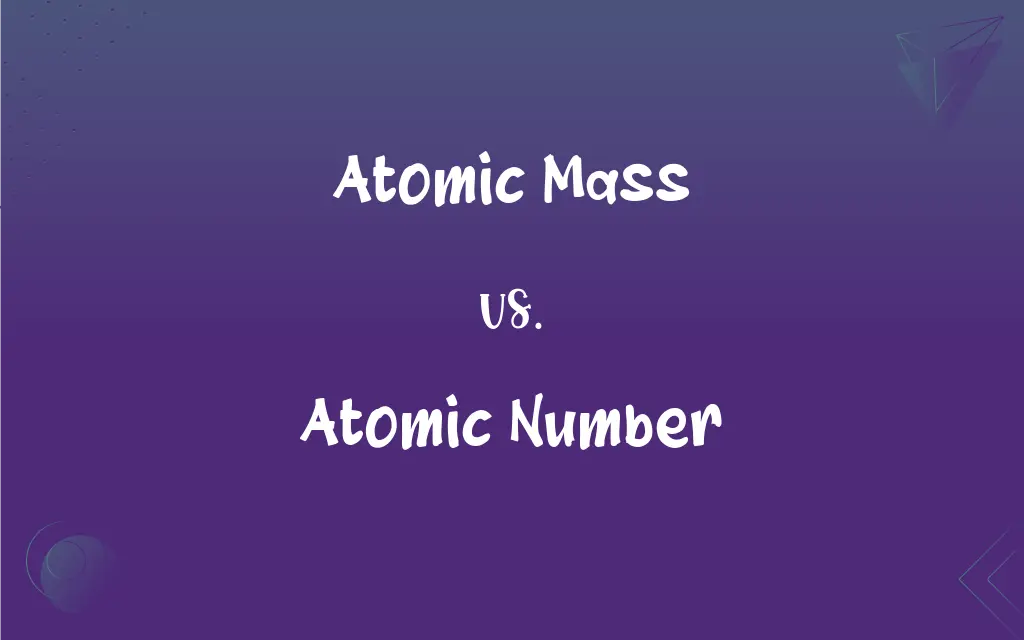Atomic Mass vs. Atomic Number: What's the Difference?
Edited by Aimie Carlson || By Harlon Moss || Updated on October 11, 2023
Atomic mass (measured in atomic mass units, amu) reflects the number of protons and neutrons in an atom. Atomic number is the count of protons in an atom's nucleus, defining the element.

Key Differences
Atomic mass and atomic number serve as pivotal terms in chemistry, though they present distinct facets of an element. The atomic mass integrates the cumulative weight of protons and neutrons residing in the nucleus of an atom. The ensuing value, gauged in atomic mass units (amu), grants insights into the element's mass relative to other elements. By contrast, the atomic number stands as the distinctive identifier for elements, steering the properties and placement within the periodic table.
Each element on the periodic table hosts a unique atomic number, segregating it from other elements. This number, denoting the total number of protons within the nucleus, steers the element's chemical persona. Comparatively, atomic mass elucidates the heft of an atom, offering a glimpse into its composition by melding the masses of both protons and neutrons. These metrics establish the foundation for comprehending atomic structure and behavior, despite their divergent focuses.
Navigating through chemical equations, atomic mass imparts crucial data regarding the weight, enabling balanced equations and stoichiometric calculations. Concurrently, the atomic number elucidates the nature and reactivity of elements by showcasing proton quantity. Both descriptors play pivotal roles in discerning an element's properties, though through varied lenses. The atomic number embodies the chemical essence of the element, whereas atomic mass provides a lens into its tangible, measurable characteristics.
Diving deeper, atomic mass is often averaged across all isotopes of an element, adjusting for their natural abundance. This average atomic mass isn’t pinned to a specific atom but mirrors an averaged, broadly applicable figure. Meanwhile, the atomic number stays static, unwavering across all isotopes of an element. The atomic number propels an element's identity, becoming a staple in elemental notation, and abetting in electron configuration predictions.
Engaging in isotopic discussions, atomic mass becomes particularly pertinent, as isotopes of an element harbor identical atomic numbers yet deviate in atomic mass. This divergence in mass arises due to the variation in the neutron count among isotopes. Oppositely, the atomic number remains a steadfast identifier, maintaining elemental consistency across all isotopic variations. Both parameters, whilst varied, synergize to render a holistic view of elemental identification and characteristics.
ADVERTISEMENT
Comparison Chart
Definition
The total mass of protons and neutrons
The total number of protons in the nucleus
Units
Atomic Mass Units (amu)
No units (it’s a count)
Variability Among Isotopes
Varies (due to neutron number variation)
Constant (proton count is always the same)
Impact on Identity
Does not define element identity
Defines element identity
Usage in Calculations
Used in stoichiometric calculations
Used to determine electron configuration
ADVERTISEMENT
Atomic Mass and Atomic Number Definitions
Atomic Mass
Atomic mass affords understanding into the weight of an element's atoms.
Hydrogen, being the lightest, has an atomic mass close to 1 amu.
Atomic Number
It is a unique identifier that differentiates one element from another.
Carbon is distinct from other elements because it has an atomic number of 6.
Atomic Mass
Atomic mass is the total mass of protons and neutrons in an atom.
Carbon has an atomic mass of about 12 amu.
Atomic Number
The atomic number stays constant and is the same for all isotopes of an element.
All isotopes of carbon maintain an atomic number of 6, despite varying in atomic mass.
Atomic Mass
Atomic mass serves to balance chemical equations accurately.
In balancing reactions, one may consider the atomic mass of Nitrogen (14 amu) to ensure mass conservation.
Atomic Number
It defines the chemical properties of an element by determining its electron configuration.
Oxygen, with an atomic number of 8, has 8 electrons which determine its chemical bonding behavior.
Atomic Mass
It's instrumental in calculations involving molecular weight.
The molecular weight of H2O is computed using the atomic mass of Hydrogen and Oxygen.
Atomic Number
Atomic number denotes the number of protons in an atom's nucleus.
Hydrogen has an atomic number of 1 because it has one proton.
Atomic Mass
It's often presented as the average mass of all the atom’s isotopes.
Chlorine has an average atomic mass of approximately 35.45 amu.
Atomic Number
The atomic number determines the element’s position in the periodic table.
Helium is placed second in the periodic table due to its atomic number of 2.
FAQs
What does the atomic mass represent?
The atomic mass represents the total weight of protons and neutrons in an atom.
How is the atomic number used in the periodic table?
Elements are arranged in the periodic table in ascending order of their atomic numbers.
Does atomic mass impact chemical reactions?
Yes, atomic mass is crucial for calculating reactant and product masses in chemical reactions.
How does atomic number affect electron configuration?
The atomic number determines the number of electrons and thus the electron configuration.
Is the number of neutrons always equal to the atomic number?
Not always. The number of neutrons can vary, creating isotopes.
What is the atomic number?
The atomic number indicates the number of protons in an atom's nucleus.
Why do isotopes have different atomic masses?
Isotopes have different numbers of neutrons, affecting their atomic masses.
What units are used for atomic mass?
Atomic mass is measured in atomic mass units (amu).
Can an element’s atomic number change?
No, an element’s atomic number is constant and defines its identity.
Can two elements have the same atomic number?
No, the atomic number is unique to each element.
Is the atomic number equal to the number of electrons?
Yes, in a neutral atom, the atomic number equals the number of electrons.
How is average atomic mass calculated?
It's calculated by averaging the masses of isotopes, weighted by their natural abundance.
Is atomic mass the same as molar mass?
Yes, atomic mass and molar mass have numerically the same value but different units.
Does the atomic number define chemical properties?
Yes, since the atomic number determines electron configuration, it defines chemical properties.
How does the atomic number influence isotopes?
The atomic number remains constant for isotopes, ensuring they are the same element.
Can the atomic mass be used to identify an element?
No, atomic mass can’t uniquely identify an element; atomic number is required for that.
Do isotopes have the same atomic number?
Yes, isotopes of an element always have the same atomic number.
How does atomic mass impact stoichiometry?
Atomic mass is used to calculate molar masses, essential in stoichiometric calculations.
Can atomic mass be a fraction?
Yes, atomic mass can be a fraction as it often represents an average value across isotopes.
How do you find the atomic mass of an element?
Usually, it is provided in the periodic table, representing the average mass of its isotopes.
About Author
Written by
Harlon MossHarlon is a seasoned quality moderator and accomplished content writer for Difference Wiki. An alumnus of the prestigious University of California, he earned his degree in Computer Science. Leveraging his academic background, Harlon brings a meticulous and informed perspective to his work, ensuring content accuracy and excellence.
Edited by
Aimie CarlsonAimie Carlson, holding a master's degree in English literature, is a fervent English language enthusiast. She lends her writing talents to Difference Wiki, a prominent website that specializes in comparisons, offering readers insightful analyses that both captivate and inform.































































